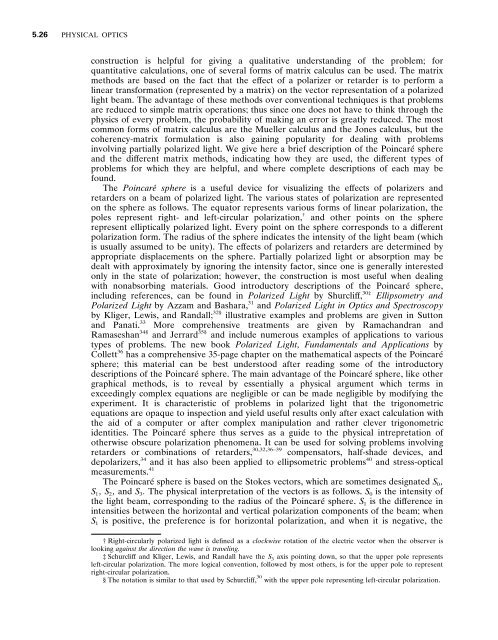Chapter 5 . Polarization
Chapter 5 . Polarization
Chapter 5 . Polarization
You also want an ePaper? Increase the reach of your titles
YUMPU automatically turns print PDFs into web optimized ePapers that Google loves.
5 .26 PHYSICAL OPTICS<br />
construction is helpful for giving a qualitative understanding of the problem ; for<br />
quantitative calculations , one of several forms of matrix calculus can be used . The matrix<br />
methods are based on the fact that the ef fect of a polarizer or retarder is to perform a<br />
linear transformation (represented by a matrix) on the vector representation of a polarized<br />
light beam . The advantage of these methods over conventional techniques is that problems<br />
are reduced to simple matrix operations ; thus since one does not have to think through the<br />
physics of every problem , the probability of making an error is greatly reduced . The most<br />
common forms of matrix calculus are the Mueller calculus and the Jones calculus , but the<br />
coherency-matrix formulation is also gaining popularity for dealing with problems<br />
involving partially polarized light . We give here a brief description of the Poincaré sphere<br />
and the dif ferent matrix methods , indicating how they are used , the dif ferent types of<br />
problems for which they are helpful , and where complete descriptions of each may be<br />
found .<br />
The Poincaré sphere is a useful device for visualizing the ef fects of polarizers and<br />
retarders on a beam of polarized light . The various states of polarization are represented<br />
on the sphere as follows . The equator represents various forms of linear polarization , the<br />
poles represent right- and left-circular polarization , † and other points on the sphere<br />
represent elliptically polarized light . Every point on the sphere corresponds to a dif ferent<br />
polarization form . The radius of the sphere indicates the intensity of the light beam (which<br />
is usually assumed to be unity) . The ef fects of polarizers and retarders are determined by<br />
appropriate displacements on the sphere . Partially polarized light or absorption may be<br />
dealt with approximately by ignoring the intensity factor , since one is generally interested<br />
only in the state of polarization ; however , the construction is most useful when dealing<br />
with nonabsorbing materials . Good introductory descriptions of the Poincaré sphere ,<br />
including references , can be found in Polarized Light by Shurclif f , 30 ‡ Ellipsometry and<br />
Polarized Light by Azzam and Bashara , 31 and Polarized Light in Optics and Spectroscopy<br />
by Kliger , Lewis , and Randall ; 32 § illustrative examples and problems are given in Sutton<br />
and Panati . 33 More comprehensive treatments are given by Ramachandran and<br />
Ramaseshan 34 § and Jerrard 35 § and include numerous examples of applications to various<br />
types of problems . The new book Polarized Light , Fundamentals and Applications by<br />
Collett 36 has a comprehensive 35-page chapter on the mathematical aspects of the Poincaré<br />
sphere ; this material can be best understood after reading some of the introductory<br />
descriptions of the Poincaré sphere . The main advantage of the Poincaré sphere , like other<br />
graphical methods , is to reveal by essentially a physical argument which terms in<br />
exceedingly complex equations are negligible or can be made negligible by modifying the<br />
experiment . It is characteristic of problems in polarized light that the trigonometric<br />
equations are opaque to inspection and yield useful results only after exact calculation with<br />
the aid of a computer or after complex manipulation and rather clever trigonometric<br />
identities . The Poincaré sphere thus serves as a guide to the physical intrepretation of<br />
otherwise obscure polarization phenomena . It can be used for solving problems involving<br />
30 , 32 , 36–39<br />
retarders or combinations of retarders , compensators , half-shade devices , and<br />
depolarizers , 34 and it has also been applied to ellipsometric problems 40 and stress-optical<br />
measurements . 41<br />
The Poincaré sphere is based on the Stokes vectors , which are sometimes designated S 0 ,<br />
S 1 , S 2 , and S 3 . The physical interpretation of the vectors is as follows . S 0 is the intensity of<br />
the light beam , corresponding to the radius of the Poincaré sphere . S 1 is the dif ference in<br />
intensities between the horizontal and vertical polarization components of the beam ; when<br />
S 1 is positive , the preference is for horizontal polarization , and when it is negative , the<br />
† Right-circularly polarized light is defined as a clockwise rotation of the electric vector when the observer is<br />
looking against the direction the wa e is tra eling .<br />
‡ Schurclif f and Kliger , Lewis , and Randall have the S 3 axis pointing down , so that the upper pole represents<br />
left-circular polarization . The more logical convention , followed by most others , is for the upper pole to represent<br />
right-circular polarization .<br />
§ The notation is similar to that used by Schurclif f , 3 0 with the upper pole representing left-circular polarization .

















